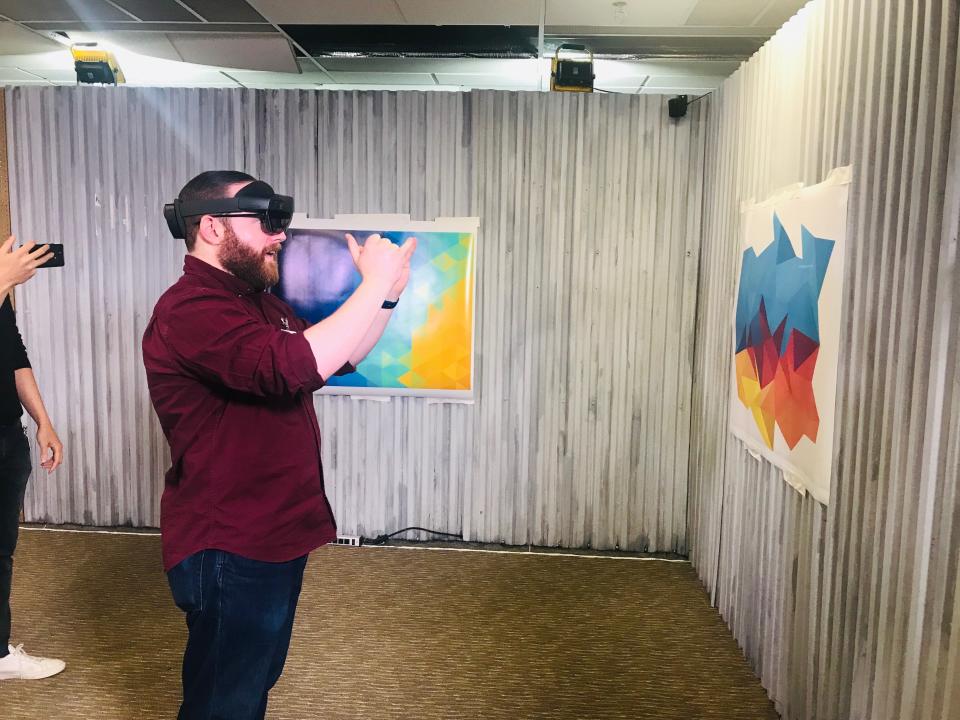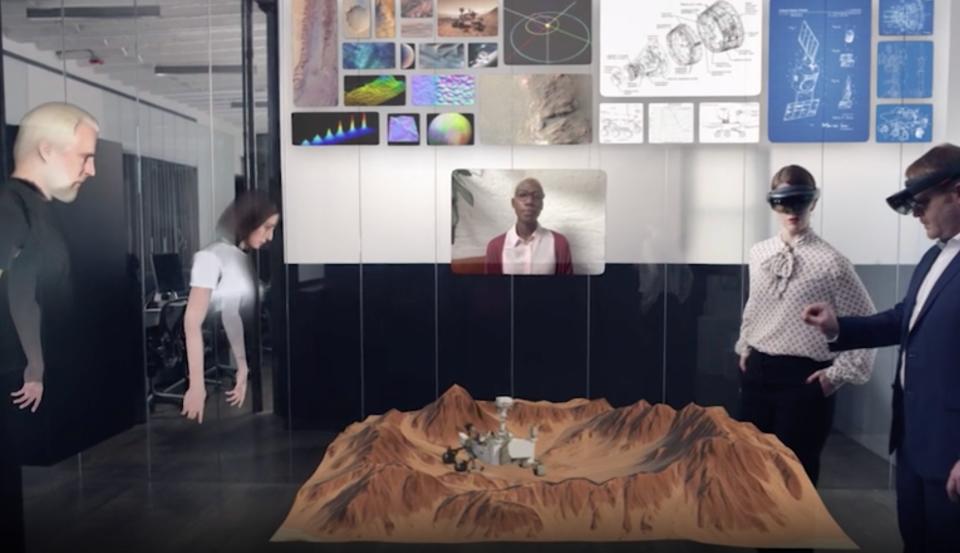How Microsoft is shaping the future of your office

Microsoft (MSFT) wants to change how and where you work. And to do that it's showing off a variety of new technologies that it believes will improve both productivity and collaboration at its annual Build Developers Conference in Seattle, Washington on May 6.
Yahoo Finance got a behind-the-scenes look at some of the most impressive tech the company is featuring at the big show, from augmented reality meetings to highly precise voice recognition software. And if Microsoft is successful, the future office will look nothing like your typical cubicle farm.
The new tech includes:
Augmented Reality meetings
Advanced digital voice assistants
Enhanced speech recognition technologies
Augmented reality meetings
In a (sort of) secretive office in one of the dozens of buildings on Microsoft's Redmond campus is a room called the "Batcave." A practice space for the company's Build demonstrations frequented by CEO Satya Nadella, the Batcave looks like a Radio Shack storage room after a bomb went off.
There’s a mock wall with two large colorful posters in the one corner of the room. It's here that the company Spatial, a third-party developer, is working on its augmented reality collaboration technology. Spatial is building its AR tech on top of Microsoft's Teams chat platform, so that users will be able to communicate in AR with ease.
I tried out an early demo of the software, and it offered a promising glimpse into the potential future of telecommuting. Users upload images of themselves to the program, which are then rendered as 3D avatars that everyone else using the app can see. As you move around with your AR headset or smartphone, your avatar moves around the virtual space.

I tested out the software using Microsoft's Hololens, the company's AR headset, and an iPhone. While wearing the headset, I was able to check out files and images that other users were working on at the same time. The idea is to turn any available space into an AR version of your office, and takes bringing your work home with you to a whole other level.
Two other Spatial employees were using the app while I was, with one in a separate room and the other next to me. The only way for me to communicate with the employee in the other room was via her avatar, though the audio setup was working, so I couldn't hear what she was saying.
Still, her avatar floated around the room, interacting with AR models and notes, just as you might in real life. I say floated around the room, because the avatar doesn't have any feet. It's a waist up, rough version of each of your coworkers. It's like having your coworkers' ghosts in your home.
That sounds, well, a bit creepy, but it should make collaborating on projects easier since speaking with someone face-to-face is always better than, say, on a video chat or over the phone. It's not going to replace being in the same room as a real-life human being, but it's pretty close.
Semantic Machines' voice recognition technology
On another side of the Batcave, Semantic Machines showed off its virtual assistant technology. Microsoft acquired Semantic Machines in 2018 to create a voice assistant that you can speak to like a normal human.
We currently talk to virtual assistants in individual sentences with occasional add-ons. Needless to say, it makes for chatting with these pieces of software feel robotic and unnatural. But what Microsoft and Semantic Machines have put together is anything but.
In a video presentation, a woman uses the company's virtual assistant to do everything from check her calendar, change appointments around, find information on the web, and more within a single conversational thread. There was no recalling the assistant with an activation phrase — it simply listened for everything the woman asked and used context to provide her with the answers she was looking for.
It's exactly the kind of thing that voice assistants like Google's (GOOG, GOOGL) Assistant, Amazon's (AMZN) Alexa, Apple's (AAPL) Siri and Microsoft's own Cortana are missing, and could make assistants more useful than for simply checking the weather and sports scores.
Still, I only saw a video demonstration of the technology, and wasn't able to try it one my own — so I can't say how close it is to becoming a reality. But if it's anything like what Microsoft is presenting, it could change voice assistants as we think of them.
Azure Speech Services
The final demo on display inside the Batcave was something called Microsoft's Azure Speech Services. While not as far out as a conversational voice assistant or AR meeting, the tech behind this demo was impressive to see.
Essentially, Speech Services allows companies to use their own internal documents, emails, etc. to teach a machine learning algorithm how to accurately transcribe even the most niche phrases. During the demo I saw, the software transcribed the kind of acronyms developers and healthcare professionals use that most transcription software would fumble over. I'm talking about things like C#, FHIR and RESTful API.
It does this by using context from the entire previous paragraph to recognize that you're talking about a specific subject. So for FHIR, the software would understand that you're talking about healthcare and recognize what you say as FHIR (fast healthcare interoperability resources) and not fire.
The software is still in its research phase, but Microsoft envisions companies being able to adopt this and use it to successfully transcribe meetings without someone having to go back and edit acronyms and phrases that other recognition programs miss.
If these advancements come to fruition and reach your average worker, they could truly change the office as we know it. The key is ensuring that they don't also push work further into employees' personal lives.
More from Dan:
Email Daniel Howley at [email protected]; follow him on Twitter at@DanielHowley. Follow Yahoo Finance on Facebook, Twitter, Instagram, andLinkedIn.www.webdesignerhoster.com/
